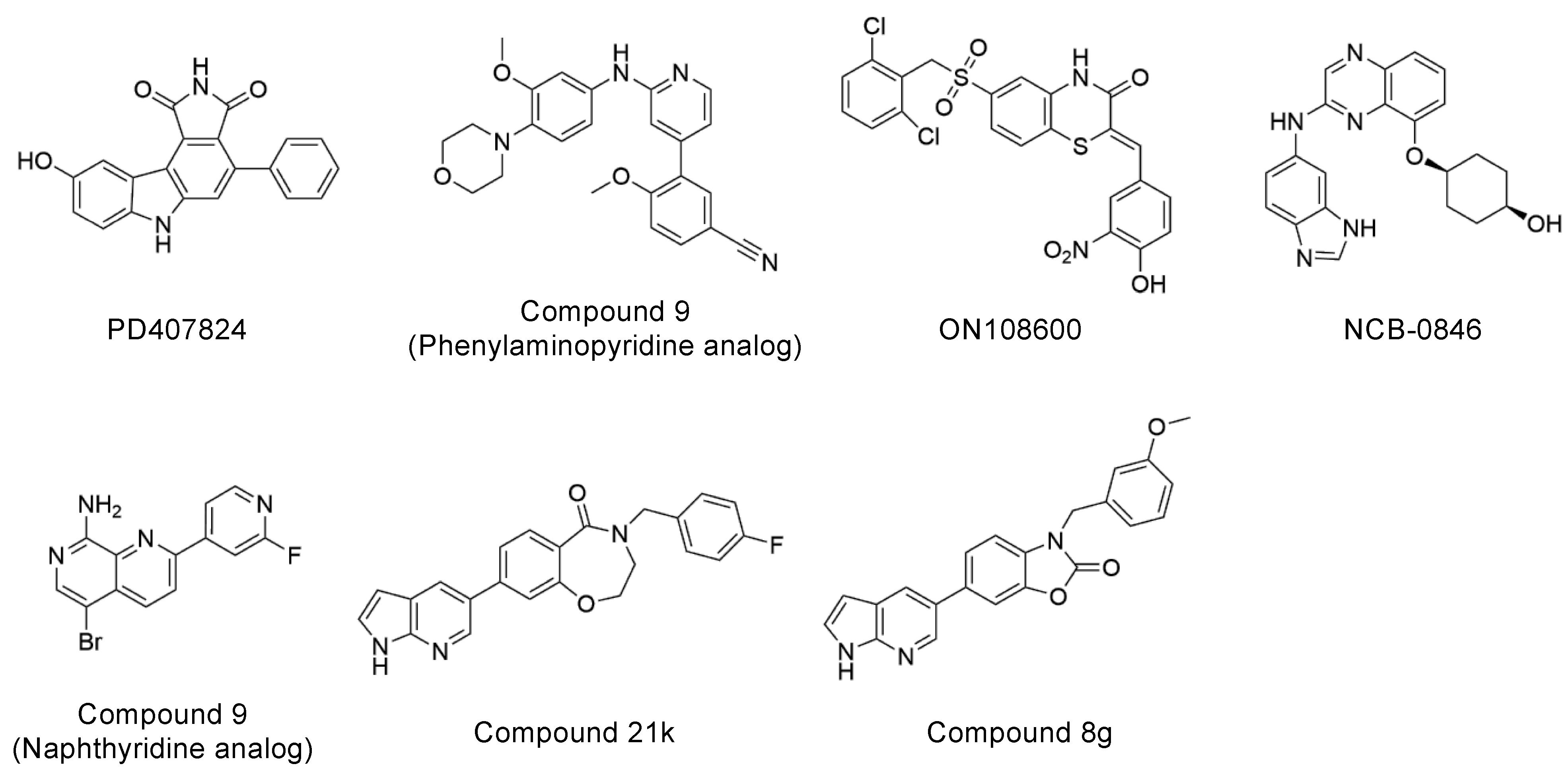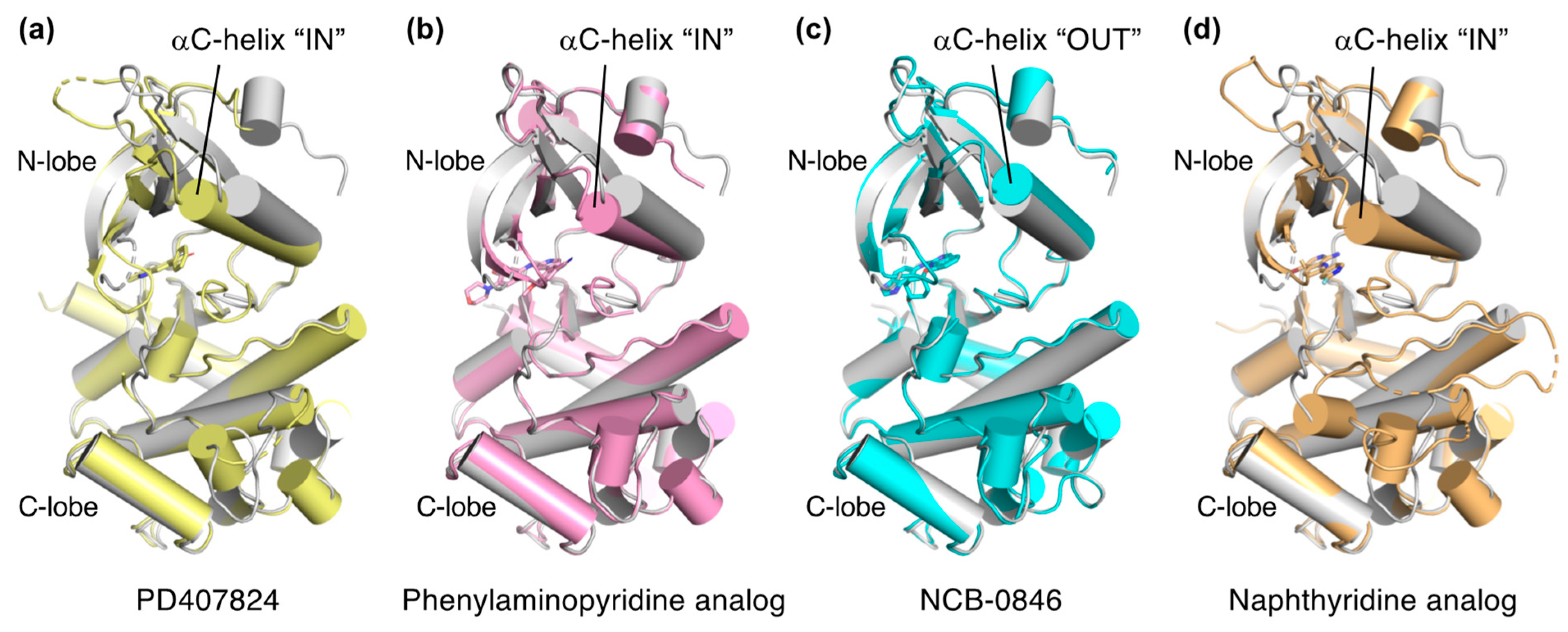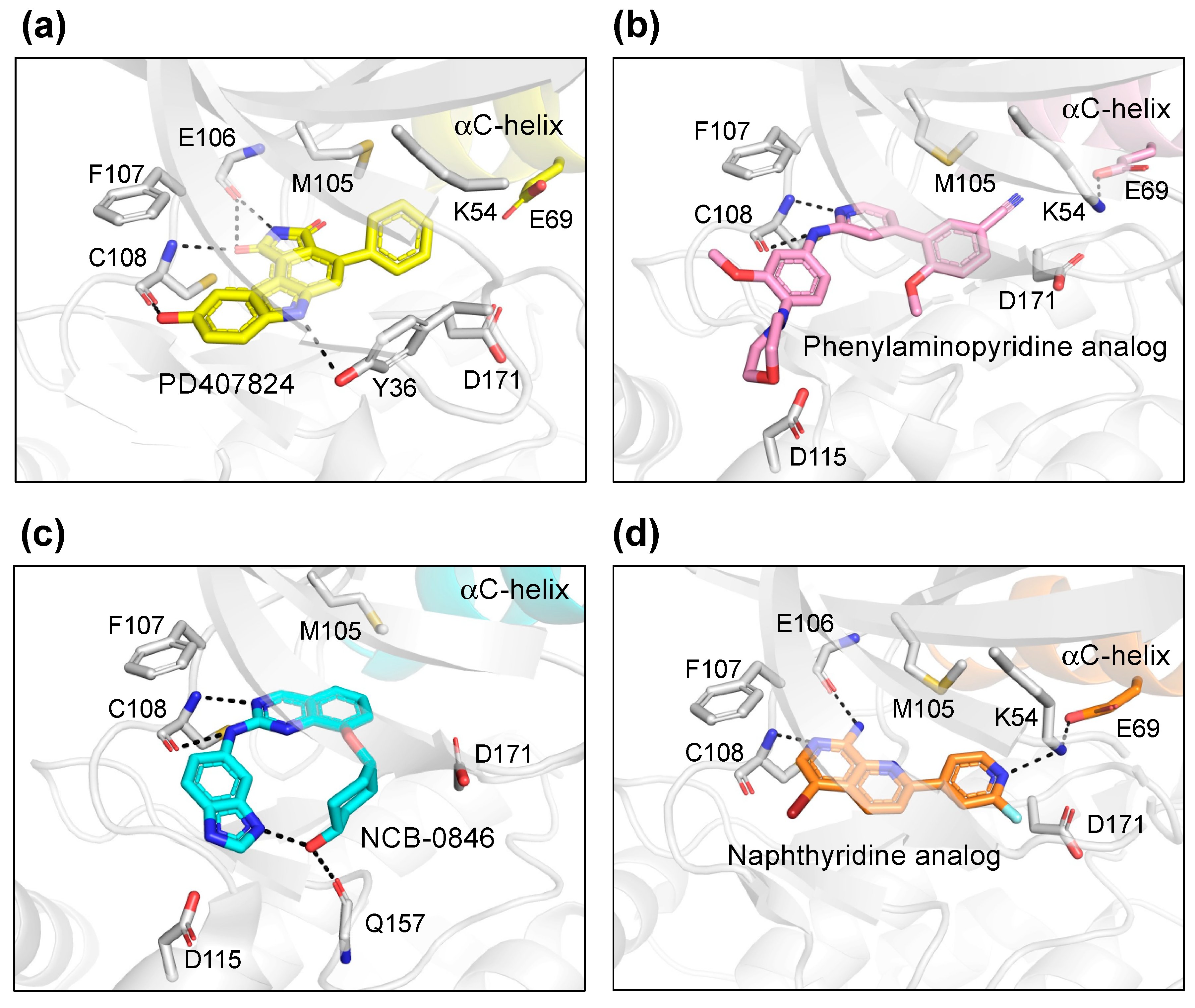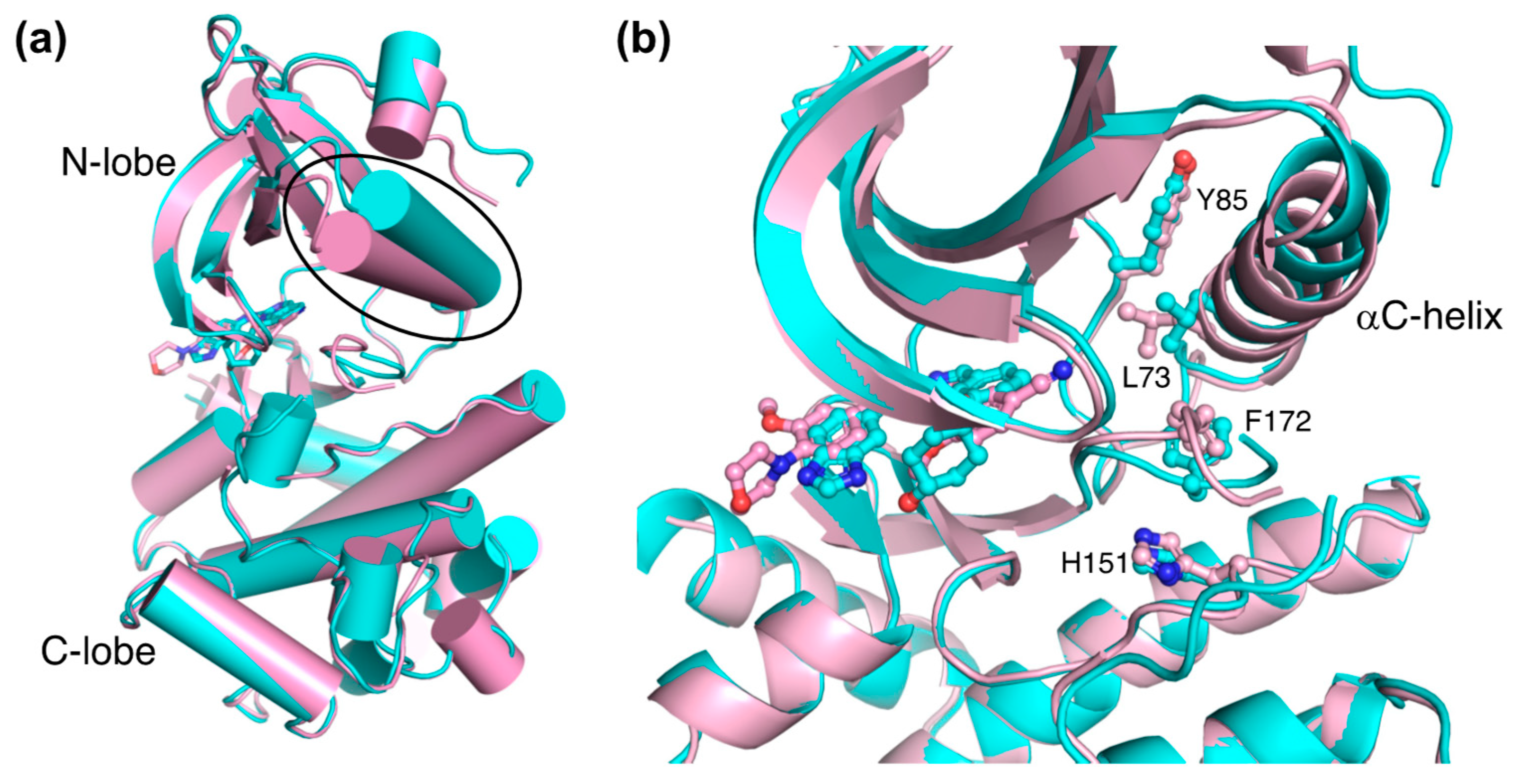Structural Insight into TNIK Inhibition
Abstract
:1. TNIK as a Druggable Target of Wnt Signaling
2. Overall Structure of the Kinase Domain
3. Effects of Inhibitor Binding on the Structure of TNIK
3.1. Wee1Chk1 Inhibitor PD407824
3.2. Phenylaminopyridine-Based Inhibitors
3.3. NCB-0846
3.4. Naphthyridine-Based Inhibitors
3.5. ON108600
4. Perspectives for the Molecular Design of Future Inhibitors
5. Structural Model of Full-Length TNIK Indicates Scaffold Function
6. Conclusions
Author Contributions
Funding
Institutional Review Board Statement
Informed Consent Statement
Data Availability Statement
Conflicts of Interest
References
- Fu, C.A.; Shen, M.; Huang, B.C.; Lasaga, J.; Payan, D.G.; Luo, Y. TNIK, a novel member of the germinal center kinase family that activates the c-Jun N-terminal kinase pathway and regulates the cytoskeleton. J. Biol. Chem. 1999, 274, 30729–30737. [Google Scholar] [CrossRef] [PubMed] [Green Version]
- Taira, K.; Umikawa, M.; Takei, K.; Myagmar, B.E.; Shinzato, M.; Machida, N.; Uezato, H.; Nonaka, S.; Kariya, K. The Traf2- and Nck-interacting kinase as a putative effector of Rap2 to regulate actin cytoskeleton. J. Biol. Chem. 2004, 279, 49488–49496. [Google Scholar] [CrossRef] [PubMed] [Green Version]
- Shitashige, M.; Satow, R.; Honda, K.; Ono, M.; Hirohashi, S.; Yamada, T. Regulation of Wnt signaling by the nuclear pore complex. Gastroenterology 2008, 134, 1961–1971. [Google Scholar] [CrossRef]
- Mahmoudi, T.; Li, V.S.; Ng, S.S.; Taouatas, N.; Vries, R.G.; Mohammed, S.; Heck, A.J.; Clevers, H. The kinase TNIK is an essential activator of Wnt target genes. EMBO J. 2009, 28, 3329–3340. [Google Scholar] [CrossRef] [PubMed]
- Korinek, V.; Barker, N.; Morin, P.J.; van Wichen, D.; de Weger, R.; Kinzler, K.W.; Vogelstein, B.; Clevers, H. Constitutive transcriptional activation by a beta-catenin-Tcf complex in APC−/− colon carcinoma. Science 1997, 275, 1784–1787. [Google Scholar] [CrossRef] [PubMed] [Green Version]
- Reya, T.; Clevers, H. Wnt signalling in stem cells and cancer. Nature 2005, 434, 843–850. [Google Scholar] [CrossRef] [PubMed]
- Shitashige, M.; Satow, R.; Jigami, T.; Aoki, K.; Honda, K.; Shibata, T.; Ono, M.; Hirohashi, S.; Yamada, T. Traf2- and Nck-interacting kinase is essential for Wnt signaling and colorectal cancer growth. Cancer Res. 2010, 70, 5024–5033. [Google Scholar] [CrossRef] [PubMed] [Green Version]
- Roskoski, R., Jr. A historical overview of protein kinases and their targeted small molecule inhibitors. Pharmacol. Res. 2015, 100, 1–23. [Google Scholar] [CrossRef] [PubMed]
- Masuda, M.; Sawa, M.; Yamada, T. Therapeutic targets in the Wnt signaling pathway: Feasibility of targeting TNIK in colorectal cancer. Pharmacol. Ther. 2015, 156, 1–9. [Google Scholar] [CrossRef] [PubMed] [Green Version]
- Sawa, M.; Masuda, M.; Yamada, T. Targeting the Wnt signaling pathway in colorectal cancer. Expert Opin. Ther. Targets 2016, 20, 419–429. [Google Scholar] [CrossRef] [PubMed]
- Yamada, T.; Masuda, M. Emergence of TNIK inhibitors in cancer therapeutics. Cancer Sci. 2017, 108, 818–823. [Google Scholar] [CrossRef] [PubMed] [Green Version]
- Masuda, M.; Uno, Y.; Ohbayashi, N.; Ohata, H.; Mimata, A.; Kukimoto-Niino, M.; Moriyama, H.; Kashimoto, S.; Inoue, T.; Goto, N.; et al. TNIK inhibition abrogates colorectal cancer stemness. Nat. Commun. 2016, 7, 12586. [Google Scholar] [CrossRef] [PubMed] [Green Version]
- Akamine, P.; Madhusudan; Wu, J.; Xuong, N.H.; Ten Eyck, L.F.; Taylor, S.S. Dynamic features of cAMP-dependent protein kinase revealed by apoenzyme crystal structure. J. Mol. Biol. 2003, 327, 159–171. [Google Scholar] [CrossRef]
- Uno, Y.; Moriyama, H.; Kashimoto, S.; Kawase, Y.; Shitashige, M.; Sawa, M.; Yamada, T. Targeting Wnt signaling: Discovery and characterization of novel thiazole-based Traf2- and NCK-interacting kinase (TNIK) inhibitors. Mol. Cancer Ther. 2013, 12 (Suppl. 11), B265. [Google Scholar] [CrossRef]
- Yamada, T.; Shitashige, M.; Yokota, K.; Sawa, M.; Moriyama, H. Tnik Inhibitor and the Use. WO2010064111, 1 December 2008. [Google Scholar]
- Kim, J.; Moon, S.H.; Kim, B.T.; Chae, C.H.; Lee, J.Y.; Kim, S.H. A novel aminothiazole KY-05009 with potential to inhibit Traf2- and Nck-interacting kinase (TNIK) attenuates TGF-β1-mediated epithelial-to-mesenchymal transition in human lung adenocarcinoma A549 cells. PLoS ONE 2014, 9, e110180. [Google Scholar] [CrossRef] [Green Version]
- Ho, K.K.; Parnell, K.M.; Yuan, Y.; Xu, Y.; Kultgen, S.G.; Hamblin, S.; Hendrickson, T.F.; Luo, B.; Foulks, J.M.; McCullar, M.V.; et al. Discovery of 4-phenyl-2-phenylaminopyridine based TNIK inhibitors. Bioorg. Med. Chem. Lett. 2013, 23, 569–573. [Google Scholar] [CrossRef]
- Padgaonkar, A.; Cosenza, S.; Pallela, V.; Subbaiah, D.V.; Reddy, M.V.R.; Reddy, E.P. The dual CK2/TNIK inhibitor, ON108600 targets cancer stem cells and induces apoptosis of paclitaxel resistant triple-negative breast cancer cells. Cancer Res. 2015, 75 (Suppl. 15), 4453. [Google Scholar] [CrossRef]
- Sato, K.; Padgaonkar, A.A.; Baker, S.J.; Cosenza, S.C.; Rechkoblit, O.; Subbaiah, D.R.C.V.; Domingo-Domenech, J.; Bartkowski, A.; Port, E.R.; Aggarwal, A.K.; et al. Simultaneous CK2/TNIK/DYRK1 inhibition by 108600 suppresses triple negative breast cancer stem cells and chemotherapy-resistant disease. Nat. Commun. 2021, 12, 4671. [Google Scholar] [CrossRef]
- Sekita, T.; Yamada, T.; Kobayashi, E.; Yoshida, A.; Hirozane, T.; Kawai, A.; Uno, Y.; Moriyama, H.; Sawa, M.; Nagakawa, Y.; et al. Feasibility of Targeting Traf2-and-Nck-Interacting Kinase in Synovial Sarcoma. Cancers 2020, 12, 1258. [Google Scholar] [CrossRef]
- Sugano, T.; Masuda, M.; Takeshita, F.; Motoi, N.; Hirozane, T.; Goto, N.; Kashimoto, S.; Uno, Y.; Moriyama, H.; Sawa, M.; et al. Pharmacological blockage of transforming growth factor-β signalling by a Traf2- and Nck-interacting kinase inhibitor, NCB-0846. Br. J. Cancer 2021, 124, 228–236. [Google Scholar] [CrossRef]
- Tan, Z.; Chen, L.; Zhang, S. Comprehensive Modeling and Discovery of Mebendazole as a Novel TRAF2- and NCK-interacting Kinase Inhibitor. Sci. Rep. 2016, 6, 33534. [Google Scholar] [CrossRef] [PubMed]
- Wang, Q.; Amato, S.P.; Rubitski, D.M.; Hayward, M.M.; Kormos, B.L.; Verhoest, P.R.; Xu, L.; Brandon, N.J.; Ehlers, M.D. Identification of Phosphorylation Consensus Sequences and Endogenous Neuronal Substrates of the Psychiatric Risk Kinase TNIK. J. Pharmacol. Exp. Ther. 2016, 356, 410–423. [Google Scholar] [CrossRef] [PubMed] [Green Version]
- Sun, Y.; Gao, X.; Wu, P.; Wink, M.; Li, J.; Dian, L.; Liang, Z. Jatrorrhizine inhibits mammary carcinoma cells by targeting TNIK mediated Wnt/β-catenin signalling and epithelial-mesenchymal transition (EMT). Phytomedicine 2019, 63, 153015. [Google Scholar] [CrossRef] [PubMed]
- Read, J.; Collie, I.T.; Nguyen-McCarty, M.; Lucaj, C.; Robinson, J.; Conway, L.; Mukherjee, J.; McCall, E.; Donohoe, G.; Flavell, E.; et al. Tool inhibitors and assays to interrogate the biology of the TRAF2 and NCK interacting kinase. Bioorg. Med. Chem. Lett. 2019, 29, 1962–1967. [Google Scholar] [CrossRef]
- Yang, B.; Wu, Q.; Huan, X.; Wang, Y.; Sun, Y.; Yang, Y.; Liu, T.; Wang, X.; Chen, L.; Xiong, B.; et al. Discovery of a series of 1H-pyrrolo[2,3-b]pyridine compounds as potent TNIK inhibitors. Bioorg. Med. Chem. Lett. 2021, 33, 127749. [Google Scholar] [CrossRef]
- Li, Y.; Zhang, L.; Yang, R.; Qiao, Z.; Wu, M.; Huang, C.; Tian, C.; Luo, X.; Yang, W.; Zhang, Y.; et al. Discovery of 3,4-Dihydrobenzo[f][1,4]oxazepin-5(2H)-one Derivatives as a New Class of Selective TNIK Inhibitors and Evaluation of Their Anti-Colorectal Cancer Effects. J. Med. Chem. 2022, 65, 1786–1807. [Google Scholar] [CrossRef]
- Luo, X.; Yang, R.; Li, Y.; Zhang, L.; Yang, S.; Li, L. Discovery of benzo[d]oxazol-2(3H)-one derivatives as a new class of TNIK inhibitors for the treatment of colorectal cancer. Bioorg. Med. Chem. Lett. 2022, 67, 128745. [Google Scholar] [CrossRef]
- Squire, C.J.; Dickson, J.M.; Ivanovic, I.; Baker, E.N. Structure and inhibition of the human cell cycle checkpoint kinase, Wee1A kinase: An atypical tyrosine kinase with a key role in CDK1 regulation. Structure 2005, 13, 541–550. [Google Scholar] [CrossRef] [Green Version]
- Palmer, B.D.; Thompson, A.M.; Booth, R.J.; Dobrusin, E.M.; Kraker, A.J.; Lee, H.H.; Lunney, E.A.; Mitchell, L.H.; Ortwine, D.F.; Smaill, J.B.; et al. 4-Phenylpyrrolo[3,4-c]carbazole-1,3(2H,6H)-dione inhibitors of the checkpoint kinase Wee1. Structure-activity relationships for chromophore modification and phenyl ring substitution. J. Med. Chem. 2006, 49, 4896–4911. [Google Scholar] [CrossRef]
- Smaill, J.B.; Baker, E.N.; Booth, R.J.; Bridges, A.J.; Dickson, J.M.; Dobrusin, E.M.; Ivanovic, I.; Kraker, A.J.; Lee, H.H.; Lunney, E.A.; et al. Synthesis and structure-activity relationships of N-6 substituted analogues of 9-hydroxy-4-phenylpyrrolo[3,4-c]carbazole-1,3(2H,6H)-diones as inhibitors of Wee1 and Chk1 checkpoint kinases. Eur. J. Med. Chem. 2008, 43, 1276–1296. [Google Scholar] [CrossRef]
- Chaikuad, A.; Keates, T.; Vincke, C.; Kaufholz, M.; Zenn, M.; Zimmermann, B.; Gutiérrez, C.; Zhang, R.G.; Hatzos-Skintges, C.; Joachimiak, A.; et al. Structure of cyclin G-associated kinase (GAK) trapped in different conformations using nanobodies. Biochem. J. 2014, 459, 59–69. [Google Scholar] [CrossRef] [PubMed] [Green Version]
- Crawford, T.D.; Ndubaku, C.O.; Chen, H.; Boggs, J.W.; Bravo, B.J.; Delatorre, K.; Giannetti, A.M.; Gould, S.E.; Harris, S.F.; Magnuson, S.R.; et al. Discovery of selective 4-Amino-pyridopyrimidine inhibitors of MAP4K4 using fragment-based lead identification and optimization. J. Med. Chem. 2014, 57, 3484–3493. [Google Scholar] [CrossRef] [PubMed]
- Jumper, J.; Evans, R.; Pritzel, A.; Green, T.; Figurnov, M.; Ronneberger, O.; Tunyasuvunakool, K.; Bates, R.; Žídek, A.; Potapenko, A.; et al. Highly accurate protein structure prediction with AlphaFold. Nature 2021, 596, 583–589. [Google Scholar] [CrossRef] [PubMed]
- Kornev, A.P.; Taylor, S.S. Dynamics-Driven Allostery in Protein Kinases. Trends Biochem. Sci. 2015, 40, 628–647. [Google Scholar] [CrossRef] [Green Version]
- Bartual, S.G.; Wei, W.; Zhou, Y.; Pravata, V.M.; Fang, W.; Yan, K.; Ferenbach, A.T.; Lockhart, D.E.A.; van Aalten, D.M.F. The citron homology domain as a scaffold for Rho1 signaling. Proc. Natl. Acad. Sci. USA 2021, 118, e2110298118. [Google Scholar] [CrossRef]
- Shvarev, D.; Schoppe, J.; König, C.; Perz, A.; Füllbrunn, N.; Kiontke, S.; Langemeyer, L.; Januliene, D.; Schnelle, K.; Kümmel, D.; et al. Structure of the HOPS tethering complex, a lysosomal membrane fusion machinery. eLife 2022, 11, e80901. [Google Scholar] [CrossRef]






| Inhibitor | Chemical Skeleton | IC50 of TNIK Activity | Biological Activity | PDB ID (Conformation) |
|---|---|---|---|---|
| PD407824 | Phenylpyrrolocarbazole | 0.7 nM [9] | - | 2X7F (closed/active) |
| NCB-0001 | Aminothiazole | 9 nM [14] | - | - |
| NCB-0005 [15]/ KY-05009 | Aminothiazole | Ki = 100 nM [16] | Anti-Wnt signaling [16] Anti-TGFβ-activated EMT [16] | - |
| Compound 9 | Phenylaminopyridine | 8 nM [17] | No anti-Wnt signaling [17] No effect on colorectal cancer cell viability [17] | 5AX9 [12] (closed/active) |
| ON108600 [18] | Benzothiazinone | 5 nM [19] (5 nM for CK2α1) (7 nM for DYRK1B) | Anti-TNBC cell growth [19] Anti-tumorigenesis in TNBC [19] Anti-TNBC metastasis [19] | - |
| NCB-0846 | Quinazoline | 21 nM [12] | Anti-Wnt signaling [12] Anti-colorectal cancer cell growth/stemness [12] Anti-tumorigenesis in colorectal cancer [12] Anti-tumorigenesis in synovial sarcoma [20] Anti-TGFβ-activated EMT [21] | 5D7A [12] (open/inactive) |
| Mebendazole | Benzimidazole | Kd ~ 1 μM [22] | - | - |
| PF-794 | Aminopyridine | 39 nM [23] | Inhibits p120-catenin phosphorylation in cells [23] | - |
| Jatrorrhizine | Isoquinoline | - | Anti-Wnt signaling [24] Anti-EMT [24] Anti-mammary carcinoma cell growth [24] | - |
| Compounds 9, 10 | Naphthyridine | 8 nM, 7 nM [25] | Inhibits phosphorylation in cells [25] | 6RA5, 6RA7 [25] (closed/active) |
| Compound 16 | Pyrrolopyridine | 0.13 nM [26] | Inhibits IL2 secretion [26] | - |
| Compound 21k | Dihydrobenzoxazepinone | 26 nM [27] | Anti-Wnt signaling [27] Anti-colorectal cancer cell growth [27] Anti-tumorigenesis in colorectal cancer [27] | - |
| Compound 8g | Benzoxazolone | 50 nM [28] | Anti-Wnt signaling [28] Anti-colorectal cancer cell growth [28] | - |
Publisher’s Note: MDPI stays neutral with regard to jurisdictional claims in published maps and institutional affiliations. |
© 2022 by the authors. Licensee MDPI, Basel, Switzerland. This article is an open access article distributed under the terms and conditions of the Creative Commons Attribution (CC BY) license (https://creativecommons.org/licenses/by/4.0/).
Share and Cite
Kukimoto-Niino, M.; Shirouzu, M.; Yamada, T. Structural Insight into TNIK Inhibition. Int. J. Mol. Sci. 2022, 23, 13010. https://doi.org/10.3390/ijms232113010
Kukimoto-Niino M, Shirouzu M, Yamada T. Structural Insight into TNIK Inhibition. International Journal of Molecular Sciences. 2022; 23(21):13010. https://doi.org/10.3390/ijms232113010
Chicago/Turabian StyleKukimoto-Niino, Mutsuko, Mikako Shirouzu, and Tesshi Yamada. 2022. "Structural Insight into TNIK Inhibition" International Journal of Molecular Sciences 23, no. 21: 13010. https://doi.org/10.3390/ijms232113010
APA StyleKukimoto-Niino, M., Shirouzu, M., & Yamada, T. (2022). Structural Insight into TNIK Inhibition. International Journal of Molecular Sciences, 23(21), 13010. https://doi.org/10.3390/ijms232113010






